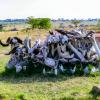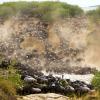Kenya's top 7 tribes
Kenya has a unique set of cultures and traditions, both culturally and ethnically. In Kenya ethnicity is so important, that in this East African country there are over 40 different ethnic groups. Kenya has a majority of the languages – Nilotic (30%), Bantus (67%) and Cushitic. Lingua has three language communities. There is also a population of Asian, European and Kenyan Arabs.
The Bantu group is Kenya's largest ethnic group. The Kikuyu, Akamba, Luhya, Kisii, Meru and Mijikenda tribes are comprised. The Bantu people rely mainly on the cultivation of foodstuffs for ordinary staples and cash, including coffee and tea. The tribe of Mijikenda gave rise to the famous Swahili culture through interaction with Arab and Persian traders. Swahili has earned the position of Kenya's official language, alongside Englisch, and is the most widely spoken language in Kenya.
The other main community in Kenya is the Nilotes group. It is made up of the tribes Maasai, Luo, Turkana, Samburu and Kalenjin. This group's people are called hunters and warriors. In their living style the nilotes are largely nomadic. The Maasai people are known for their cultural heritage throughout the world. Take a safari in the Kenya jungle and you'll find many of the following tribes: –
1. Kikuyu
Kikuyu is one of all the tribes in Kenya and has its own cultural and traditional background. The Bantu group is a population of 22 per cent in Kenya and mainly resides in the central region of Kenya. The Kikuyus is famous for being big farmers of cash crops like coffee and tea. The community adores a deity called "Ngai," who is thought to live in Kenya Mount.
If a man of Kikuyu can fulfill their needs he is allowed to marry more than one woman. A major part of their culture is the practice of paying bridal prices. Even in urban areas, where the majority of people speak Swahili and English, Kikuyu has managed to maintain its importance. Kikuyu people are known for their tendency to money and for their business activities they are reported to be aggressive.
2. Luhya
The Luhyas constitute 14 per cent of the Kenyan population and is the second largest tribe in Kenya. Mainly in the western part of Kenya this bantu group is based. It is a group of more than 18 subtribes, which each practice their own Luhya dialect. The subdivisions of Luhya are Bukusu, Maragoli, Banyore, Batsotso, Gisu, Idakho, Isukha, Kabras, Khayo, Kisa, Marachi, Marama, Masaaba, Tacho, Tiriki and Wanga. They live in the fertile western region of Kenya and worship "Nyasaye" or "Were Khakaba" traditionally as their god.
In most subtribes of Luhya, male circumcision marks the transition from childhood to manhood. Bullfighting is a popular sport of the tribe and also a popular popular luhya dish, including Ugali, for their food love.
3. Kisii
Six per cent of Kenya's population are in this 7th largest tribe in Kenya. These people live in Nyanza in western Kenya, the highly fertile mountains. The families of Kisii often live close by and share day-to-day activities like cooking or agriculture. Men can have more than one wife and have the highest power in their families. This tribe was obligatory in the practice of female circumcision. Now this ritual is still practiced in some places even though it has been prohibited. Nevertheless, male circumcision is still practiced to mark boys' adult initiation.
Bananas are grown in their communities on a large scale, and the practice is known as 'Matoke.' The supreme gods 'Engoro' and ancestral spirits are all prayed by this Kenyan tribe. The culture of Kisii is famous for its soapstone, basketry and ceramics. The people of Kisii are famous for being short-tempered.
4. Mijikenda
Mijikenda is a large Kenyan Bantu tribe comprising nine sub-tribes, the culture of which revolves around clans and ages. Mijikenda is comprised of sub-tribes of Giriama, Digo, Chonyi, Duruma, Jibana, Kambe, Kauma, Rabai, and Ribe. The tribe of Kenya is home to approximately 1,960,574 million people. Mijikenda is regarded by the Swahili culture as one of the most important tribes in Kenya.
A clan of Mijikenda usually consists of a number of families who share one patriarchal ancestor. Each clan is known as a sacred place, kaya, shared for rituals such as priests, sacrifices, etc.
Some of the best cooks are known for the Mijikenda, and in particular the Digos. Wali, a dish made with Rice and coconut milk, is the main food of this tribe. The Mijikenda cuisine is also used for fish and other seafood.
5. Maasai
The Maasai tribe, with a small population of 841,622, is one of Kenya's most popular tribes known for its cultural and historical closeness and harmonized with the modern way of life. Their dressing, red-stretched shukas and other typical regalias fascinate nearby and far people. In central and southern Kenya and northern Tanzania, the Maasai people live in people looking for things in Kenya.
In ten to twenty small huts, Maasai families live at the hub. The Enkang enclosure is sheltered by a fence or sharp thorn bushes. Maasai people's lives focus on the main source of food for cattle. The need to find new pasturelands for livestock makes them semimadic. The richer a man takes into account the more cattle a man has.
Kenyan Massai or Masai people believe in a supreme god and called it Enkai. And that is what they call Enkai. Massai "Moran" is a critical rite of passage for men who live alone, learn tribal habits for some time and develop strength, courage and stamina to become the known "warriors." The Kenyan population is known for its height.
6. Luo
Luo is one of the biggest Kenyan tribes, accounting for 13% of the population. In the western region of Kenya (Nyanza) the ethnic group lives. The people rely on fishing as a livelihood source. They often say no Luo is complete without fish.
The removal during circumcision of six young men's lower teeth, which makes Luo people distinct from other ones, is an important tradition in this tribe. A unique thing known as "professional mourners," which are often paid for by a group of locals to grieve for others, is employed by people of this community. Luo people are also reputed to praise and blossom.
7. Kalejin
The Kalenjin people, which make up 12% of Kenya's population, are the 3rd most populous ethnic group in Kenya. Eight tribs, namely Kipsigi, Nandi, Tugen, Keiyo, Marakwet, Pokot, Sabaot, and the Terikh, make up the Kalenjin tribe.
In rounded huts built of bent saplings and the mix of mud and cow dung, people of the Kalenjin live together. They are also involved in large-scale livelihood farming. They also work in livestock husbandry. The Kalejin tribe is popular in Kenya and in other areas with 'Mirsik' (traditionally fermented milk).
The traditional practice when boys are in the early adolescence is male circumcision. They hold a monotheistic conviction and adore a god named Asia (signified by the sun). This tribe is known for its athletic superiority and is surnamed 'The Running Tribe.'
As you can find, Kenya's diversity sometimes leads to conflicts between the main groups; however, their cultural wealth is rich and forms an integral part of Kenya and Africa. You can reserve a holiday package from Kenya to explore its rich tribal culture to explore the culture here.
Source: Veena World




